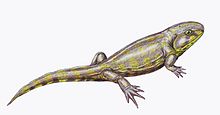| Eucritta Temporal range: Viséan
| |
|---|---|

| |
| Life restoration | |
| Scientific classification | |
| Domain: | Eukaryota |
| Kingdom: | Animalia |
| Phylum: | Chordata |
| Clade: | Sarcopterygii |
| Clade: | Tetrapodomorpha |
| Clade: | Stegocephali |
| Genus: | †Eucritta Clack, 1998 |
| Type species | |
| Eucritta melanolimnetes Clack, 1998
| |
Eucritta (meaning "true creature") is an extinct genus of stem-tetrapod from the Viséan epoch in the Carboniferous period of Scotland.[1] The name of the type and only species, E. melanolimnetes ("true creature from the black lagoon") is a homage to the 1954 horror film Creature from the Black Lagoon.[2]
Eucritta possessed many features in common with other generalized Carboniferous tetrapods and tetrapod relatives. A large amount of these features were plesiomorphic, meaning that they resembled the "primitive" condition that was acquired when four-limbed vertebrates ("amphibians", in the broad sense) first appeared. With a short, wide skull, large eyes, and strongly-built limbs, Eucritta proportionally resembled Balanerpeton, a contemporary terrestrial tetrapod which was one of the earliest members of Temnospondyli, a successful tetrapod group which may have produced modern amphibians. However, Eucritta lacked key temnospondyl adaptations, while also not showing certain adaptations of reptiliomorphs (the tetrapod lineage that would lead to reptiles and other amniotes). In other cases, it possesses certain characteristics in common with each. Its closest relatives may have been baphetids such as Megalocephalus, based on the possession of slight embayments on the front edge of the eye sockets.[2]
Eucritta's mosaic possession of characters seen in baphetids, "anthracosaurs" (early reptiliomorphs), and temnospondyls suggests that these three groups diverged in the Carboniferous rather than earlier, in the Devonian.[2] Its limb proportions support terrestrial preferences while skeletal features suggest that it utilized buccal pumping, the type of breathing used by modern amphibians.[1]
- ^ a b Clack, J. A. (March 2001). "Eucritta melanolimnetes from the Early Carboniferous of Scotland, a stem tetrapod showing a mosaic of characteristics". Earth and Environmental Science Transactions of the Royal Society of Edinburgh. 92 (1): 75–95. doi:10.1017/S0263593300000055. ISSN 1473-7116.
- ^ a b c Clack, Jennifer A. (2 July 1998). "A new Early Carboniferous tetrapod with a mélange of crown-group characters". Nature. 394 (6688): 66–69. doi:10.1038/27895. ISSN 1476-4687.